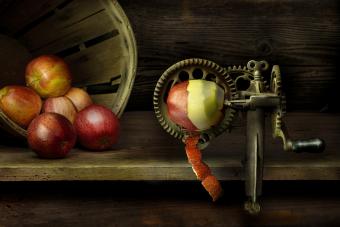
During school, birthday parties, or camp, you probably got hyped up when they broke out the little condiment bottles full of colored sand knowing you were going to make the coolest mountain ever. You've probably never thought about these sand-in-a-bottle activities being anything other than an interesting way to keep kids from running to the snack drawers or trying to jump down two flights of stairs. Yet, sand-in-a-bottle art has deep folk roots and stretches back over 100 years into the past.
Andrew Clemens Perfected Sand-in-a-Bottle Art
You can thank Andrew Clemens for inventing one of your favorite childhood crafts. Born in 1857, this Iowan was an artist at heart and took inspiration from the colorful sands in Pikes Peak State Park to experiment with creating works of art.
Carefully, he took each grain of sand and placed it into a glass bottle, layering colors throughout to create recognizable shapes and patterns. His early art was more abstract, and as he perfected his skills, the scenes transformed into sprawling, detailed landscapes and textural paintings.

Encephalitis took away Clemens's hearing at a young age, and he attended a Deaf school in the 1870s.
Most Active Period
Although he practiced his art form in the mid-1800s, the prolific pieces of work that people collect today usually come from the 1880s.
Types of Works
Unlike some artists who acquired massive patrons that paid for their projects throughout their whole lives or those who belonged to cultural institutions and academies that bolstered their reputations, Clemens's entire business was built around doing commissions.
If you lived in the 1880s, you could have paid Clemens to make a bottle of sand art personal to you. These custom bottles usually reflected folk and national imagery from the period. Think things like eagles, American flags, steamboats, flowers, and more.
Typically, Clemens's bottles feature a main image in the center that's bordered on the top, bottom, and sides with colorful quilt-like patterns.

How Does the Sand Art Work?
Clemens's sand art uses simple science to stay in place. Essentially, he would compress the sand using a cork stopper and top to seal the bottle. The immense pressure that's applied keeps every grain of sand in place so that nothing moves. We know how compelling intrusive thoughts are, but these small bottles are worth so much money, you won't want to pull a toddler move and shake it around just to see what happens.
Value of Andrew Clemmens's Sand Art Bottles
| Valuable Andrew Clemens's Sand Art Bottles | Record Sales Prices |
| Orrin T. Fuller Portrait Bottle | $956,000 |
| William and Upham Contractors Bottle | $860,000 |
| Percheron Horse Bottle | $318,750 |
| Merry Christmas Bottle | $227,575 |
| Paddlewheel Boat Bottle | $81,900 |
| American Flag and Eagle Bottle | $25,500 |
Because unconventional art with folk imagery has historically been devalued, these bottles weren't preserved in the same way that massive canvases or sculptures were. Add to it the fact that little glass apothecary bottles are fragile, and you have an art form that's largely lost to time.
Yet, there's a smattering of these unique art pieces left and because of their rarity, they sell for impressive amounts at auction. Not even 10 years ago, these bottles weren't selling for the steep five- to six-figure prices they are today.
These are some of the most expensive sand art bottles to sell in an auction in the past few years:
- A rare portrait bottle of the little boy Orrin T. Fuller sold in a Hindman auction for $956,000.
- A sand art bottle honoring the Williams and Upham Contractors for River and Harbor Improvements featuring a complicated crane image sold for $860,000 in a Hindman's auction.
- This bottle featuring a Percheron horse portrait sold for $318,750 in a 2022 Hindman's auction.
- One expensive bottle sold in 2022 at a Bonham's auction for $227,575. It dates back to 1887 and features a cross-stitch-like 'Merry Christmas' slogan.
- An 1885 bottle featuring a paddlewheel boat sold in a Sotheby's auction for $81,900.
- A bottle with a less compelling image commemorating 1886 sold for $25,500 in a 2022 Bonham's auction.
How to Tell if You Have a Rare Clemens Sand Art Bottle
With price tags like these, you should totally be on the lookout for Andrew Clemens's rare sand art. But, if you haven't looked at hundreds of pictures to know his style off the top of your head, you only need to look for two things.
Check the Bottom for a Label
The easiest thing you can look for is the label on the bottom. Most of these bottles that have come to auction still have their labels intact, which implies that they're well adhered. These circular labels feature the artist's name (A. Clemens) in the center, with the labeler (deaf mute) underneath. A filigree separates the top title (Pictured Rock Sand) from the middle and bottom title (McGregor, Iowa).
These paper labels are vital to knowing that you have a genuine Clemens and will send your auction prices through the roof.
Look for Muted, Natural Colors
Unlike the sand art today, which is almost always neon, Andrew Clemens only used naturally occurring sand. This means you should look for terra cotta reds, ochres, beach sand, yellows, oranges, and greens. If you see something with razzmatazz pink, it's not a Clemens piece.
Art Doesn't Have to Be Complicated to Be Valuable
There's an overarching theme in the art world that if an artist hasn't labored over a piece that's complicated and intellectually stimulating, then it's not worthy of acclaim. But sometimes simplicity speaks to us the most, and Andrew Clemens's sand-in-a-bottle art continues to resonate over 100 years later.







